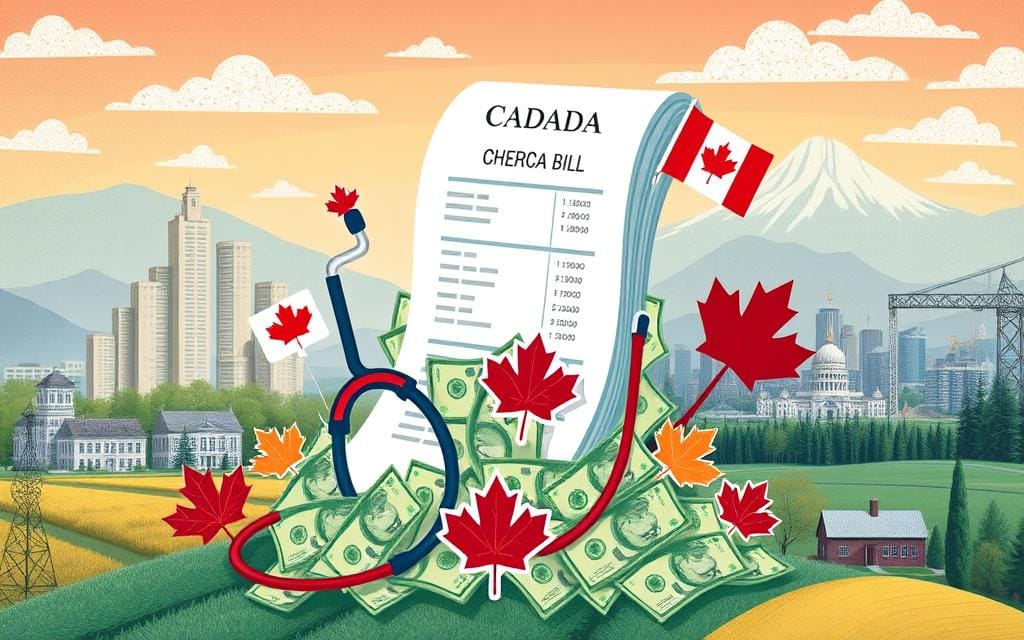advertisement
Canadians face a tough reality: the cost of living has soared. Inflation has hit its highest level in over 40 years. The average Canadian household now spends 17.7% of their monthly income on basics.
This is a big jump from the pre-pandemic average of 15.2%. Many Canadians now struggle to cover their expenses. It’s crucial to understand and adapt to our current economic climate.

This article explores the cost of living in Canada. We’ll look at housing, transportation, healthcare, and education. These are key factors driving up living expenses.
We’ll also share practical tips to help you manage your finances. Our goal is to help you make smart choices and save money.
You’ll learn how to optimize your spending and build financial resilience. This advice applies to both long-time residents and newcomers. Let’s dive into Canada’s cost of living and how to thrive despite rising costs.
Understanding the Cost of Living in Canada
Living expenses in Canada can differ greatly based on various factors. It’s important to examine the key elements that affect Canadians’ daily costs. These insights help in making informed financial decisions.
What Factors Contribute to the Cost of Living?
Several factors influence the cost of living in Canada. These include housing, transportation, food, healthcare, and utilities.
- Housing Costs: Rent, mortgage payments, and property taxes can greatly impact overall living expenses. This is especially true in major cities.
- Transportation Expenses: Vehicle ownership costs and public transit prices contribute significantly to daily expenses. These can vary depending on location and personal needs.
- Grocery and Food Prices: Food costs change based on local markets and individual eating habits. This includes groceries and dining out expenses.
- Healthcare Costs: While basic medical services are covered, additional care and medications can add to expenses. These out-of-pocket costs can affect overall living expenses.
- Utility Bills: The cost of electricity, water, and other essential services can vary. Location and usage patterns play a role in these expenses.
Regional Differences in Living Expenses
Living costs in Canada vary greatly across different regions and provinces. Regional differences in expenses for housing, transportation, and essential goods create significant disparities.
Large cities like Toronto or Vancouver generally have higher living costs. Smaller cities and rural areas tend to be more affordable. Understanding these factors affecting cost of living is crucial for budget planning.
“Living costs in Canada greatly impact financial well-being. Understanding expense drivers and regional variations is key to making smart budget decisions.”
Average Cost of Living by Province
Living costs in Canada vary widely across provinces. Let’s explore the average expenses in different regions. We’ll compare major cities and rural areas.
Cost Comparisons: Major Cities vs. Rural Areas
Major urban centers in Canada often have higher living costs than rural regions. Housing, groceries, and transportation are usually cheaper in smaller towns. However, rural areas may have fewer amenities and job options.
| Province | Average Cost of Living in Major Cities | Average Cost of Living in Rural Areas |
|---|---|---|
| Ontario | $2,500 – $3,000 per month | $1,800 – $2,200 per month |
| British Columbia | $2,800 – $3,400 per month | $2,000 – $2,400 per month |
| Quebec | $2,200 – $2,700 per month | $1,600 – $1,900 per month |
| Alberta | $2,400 – $2,900 per month | $1,900 – $2,300 per month |
Expensive Provinces: Where Does the Money Go?
British Columbia and Ontario are among Canada’s priciest provinces. High housing costs in Vancouver and the Greater Toronto Area drive up expenses. Transportation and utilities also tend to be more expensive in these regions.
Quebec and the Atlantic provinces offer lower urban vs rural living costs. This is due to more affordable housing and lower overall expenses. Knowing these differences helps Canadians make smart financial choices.
Housing Costs in Canada
Housing costs are a major expense for Canadians. The housing market can be a financial burden for renters and buyers alike. Let’s explore the current trends and challenges in Canadian housing costs.
Rental Prices: Trends in Major Cities
Renting in Canada’s big cities has become pricier in recent years. In Toronto, a one-bedroom apartment averages $1,800 monthly. Vancouver is even higher at $1,900.
Smaller cities aren’t immune to high rents. Ottawa and Calgary average around $1,400 and $1,200 respectively. These increases stem from limited supply, high demand, and inflation’s impact on real estate.
As rents climb, more Canadians struggle to find affordable housing. This has become a pressing issue for many.
Home Ownership: Affordability and Mortgage Rates
Buying a home is also getting harder for Canadians. The average home price in Canada now exceeds $700,000. This makes it tough for first-time buyers to enter the market.
Rising mortgage rates, now around 5%, add to the affordability problem. Many Canadians find homeownership out of reach due to these factors.
The mix of high housing costs and mortgage rates is concerning. Balancing rental prices and homeownership remains a big challenge across Canada.
| City | Average Rent (One-Bedroom) | Average Home Price | Mortgage Rate |
|---|---|---|---|
| Toronto | $1,800 | $800,000 | 5% |
| Vancouver | $1,900 | $1,100,000 | 5% |
| Ottawa | $1,400 | $600,000 | 5% |
| Calgary | $1,200 | $450,000 | 5% |
Transportation Costs in Canada
Getting around in Canada can be pricey. Understanding these costs helps manage living expenses. This includes public transit and private vehicle ownership.
Public Transit Costs: Monthly Passes and Pay-As-You-Go
Public transit is popular in Canadian cities. Monthly pass prices vary across the country. In Toronto, a monthly pass costs about $156, while in Vancouver it’s around $100.
Some cities offer pay-as-you-go options. These can be better for people with irregular commuting schedules.
Car Ownership: Insurance, Gas, and Maintenance
Private vehicle ownership costs can add up quickly. Car insurance premiums in Canada range from $1,000 to $2,500 yearly. Factors like age, driving record, and location affect prices.
Fuel costs are a big concern. The national average for regular gas is about $1.50 per liter. Vehicle maintenance adds to overall expenses.
| Transportation Cost in Canada | Average Cost |
|---|---|
| Monthly Public Transit Pass (Toronto) | $156 |
| Monthly Public Transit Pass (Vancouver) | $100 |
| Annual Car Insurance Premium | $1,000 – $2,500 |
| Average Gasoline Price (per liter) | $1.50 |
Knowing transportation costs in Canada helps people plan better. This includes public transit and car ownership expenses. Smart choices lead to better budgeting.
Grocery Prices and Food Costs
Canadians are worried about rising grocery costs in our high-inflation economy. Food prices are straining household budgets. Let’s look at average grocery expenses and what affects food prices in Canada.
National Average Grocery Expenses
Statistics Canada reports that Canadian households spent about $9,100 on groceries in 2022. This is a big jump, with food prices rising 6.8% across the country.
Grocery costs can differ based on where you live. People in big cities often pay more than those in rural areas.
Factors That Influence Food Prices
Several things affect food prices in Canada, including:
- Seasonality: In-season produce is cheaper. Off-season imports can make grocery expenses higher.
- Supply chain disruptions: Transportation delays and production issues can increase factors affecting food costs.
- Fuel and energy costs: Higher fuel prices impact food transport and processing, raising food prices in Canada.
- Exchange rates: Canadian dollar changes affect imported food costs, especially produce and specialty items.
- Weather and climate: Extreme weather can hurt crop yields and increase grocery expenses.
| Grocery Item | Average Price (2022) | Price Change from 2021 |
|---|---|---|
| Bread (1 loaf) | $3.50 | +5.4% |
| Milk (1 litre) | $2.25 | +3.2% |
| Eggs (1 dozen) | $4.80 | +13.2% |
| Chicken (1 kg) | $6.75 | +8.1% |
| Apples (1 kg) | $3.90 | +4.7% |
Understanding what shapes food prices in Canada can help us make smart choices. It allows us to plan our budgets better as we face rising grocery expenses.
Healthcare Expenses in Canada
Canada’s healthcare system offers universal coverage, but understanding provincial plans is vital. While public healthcare covers many services, some costs may fall on residents. It’s important to know the ins and outs of healthcare expenses.
Understanding Provincial Healthcare Coverage
Each province and territory has its own healthcare plan. These plans typically cover doctor visits, hospital stays, and some tests. However, coverage can vary between provinces.
Canadians may need to pay for services not included in their provincial plan. It’s crucial to know what’s covered and what’s not.
Out-of-Pocket Medical Expenses
Despite comprehensive coverage, Canadians may face out-of-pocket medical expenses. These can include:
- Dental care
- Prescription drugs
- Vision care, such as eye exams and eyeglasses
- Certain medical procedures and treatments not covered by the provincial plan
- Ambulance services in some cases
These expenses can add up quickly. Canadians might need to buy private insurance or budget for extra healthcare costs.
| Province | Average Annual Out-of-Pocket Healthcare Costs |
|---|---|
| Ontario | $2,500 |
| Quebec | $2,200 |
| British Columbia | $2,800 |
| Alberta | $2,400 |
Knowing the limits of provincial healthcare helps Canadians manage their costs better. It allows them to make smart choices about their healthcare needs.

Education Costs in Canada
Education costs in Canada are a hot topic for students and families. Understanding these expenses is key to making smart choices about higher learning. This includes tuition fees and other related costs.
Tuition Fees: Public vs. Private Institutions
Tuition costs vary based on the type of school. Public universities usually charge less than private ones. In 2022-2023, public university undergrad programs cost about $6,470 on average.
Private universities charged around $15,600. Some programs, like engineering and law, often cost more. International students typically pay higher fees than domestic students.
Additional Costs: Supplies and Living Expenses
Students face many expenses beyond tuition. These include textbooks, school supplies, and student activity fees. Living costs like rent, food, and transport also add up.
This is especially true for those studying away from home. These extra costs can greatly increase the overall price of education.
| Expense | Average Cost (CAD) |
|---|---|
| Textbooks and Supplies | $1,000 – $2,000 per year |
| Housing (on-campus) | $6,000 – $12,000 per year |
| Food and Meals | $3,000 – $5,000 per year |
| Transportation | $1,000 – $2,000 per year |
Education costs in Canada keep rising. Students and families must think hard about money matters. They should look into funding options like scholarships and government help.
The Impact of Inflation on Daily Living
Canadians face a growing challenge: rising inflation’s impact on daily expenses. Consumer prices are climbing, making it harder for families to maintain their living standards. Understanding this economic issue is vital for navigating today’s high-cost environment.
How Inflation Rates Affect Consumer Prices
Inflation directly impacts Canada’s cost of living. It’s the sustained increase in prices for goods and services. Statistics Canada reported a 6.8% annual inflation rate in April 2022, the highest since 1991.
This means $100 worth of goods now costs $106.80, straining household budgets. Essential items like food, housing, and transportation have been hit hardest. Grocery prices rose 8.8% over the past year, while fuel costs increased by 35.7%.
Coping Strategies for Rising Costs
Canadians need smart strategies to manage daily expenses during inflation. Some effective approaches include:
- Careful budgeting and tracking of spending to identify areas where savings can be made
- Exploring alternative, more cost-effective options for essential goods and services
- Prioritizing necessary expenses and finding ways to cut back on non-essential spending
- Increasing income through additional work or exploring government assistance programs
- Investing in assets that can maintain their value, such as real estate or stocks, to protect against the erosion of purchasing power
A proactive approach can help Canadians navigate high inflation challenges. It’s crucial to safeguard financial well-being for the long term. Smart planning can protect your wallet from rising costs.
As living costs rise, Canadians must stay informed and adaptable. Understanding inflation’s impact on prices is key. Implementing effective strategies can help maintain your standard of living during economic uncertainty.
Strategies to Manage Living Expenses
Canadians are looking for ways to handle rising costs. There are practical steps to keep your finances in check. These include budgeting tips and smart shopping strategies.
Budgeting Tips for Canadians
A realistic budget is key to managing your living expenses. Track your income and expenses to find areas to cut back. This will help you stay on top of your finances.
- Categorize your expenses into fixed (rent, mortgage, insurance) and variable (groceries, utilities, entertainment) costs.
- Set spending limits for each category and stick to them.
- Automate savings to ensure you’re regularly setting aside money for the future.
- Review your budget regularly and make adjustments as needed.
Smart Shopping: Discounts and Deals
Smart shopping can help you manage your living expenses. Look for ways to save on everyday purchases. This can make a big difference in your overall budget.
- Take advantage of loyalty programs, coupons, and price-matching offers to reduce the cost of groceries and other household items.
- Comparison shop online and in-store to find the best deals on everything from appliances to clothing.
- Opt for generic or store-brand products, which are often less expensive than name-brand alternatives.
- Consider buying in bulk for non-perishable items to take advantage of lower unit prices.
Use these strategies to manage your living expenses effectively. They can help keep your finances on track, even in a high-inflation economy.
| Budgeting Category | Average Monthly Spending | Average Annual Spending |
|---|---|---|
| Housing (rent/mortgage, utilities) | $1,500 | $18,000 |
| Transportation (car payments, gas, insurance) | $500 | $6,000 |
| Groceries | $400 | $4,800 |
| Entertainment and Dining Out | $300 | $3,600 |
| Other Expenses (clothing, healthcare, etc.) | $300 | $3,600 |
Managing these key expense categories is crucial. It helps Canadians take control of their living costs. This can lead to financial stability, even in tough economic times.
Government Assistance Programs
Canada offers many assistance programs to help with rising living costs. These social benefits and tax credits provide valuable financial support for families.
Social Benefits Available to Canadians
The Canadian social safety net includes various programs to support those in need. Here are some key social benefits:
- Canada Child Benefit (CCB): A monthly payment to eligible families with children under the age of 18 to help with the cost of raising children.
- Old Age Security (OAS) and Guaranteed Income Supplement (GIS): Retirement income support programs for seniors with low to modest incomes.
- Employment Insurance (EI): Provides temporary income support for individuals who have lost their job through no fault of their own.
- Canada Pension Plan (CPP): A mandatory retirement savings plan that provides income to eligible Canadians upon retirement.
Tax Credits and Deductions for Families
The Canadian government also offers tax credits and deductions to help families manage expenses. Here are some examples:
- Canada Child Tax Benefit (CCTB): A tax-free monthly payment to eligible families with children under the age of 18.
- Child Care Expense Deduction: Allows parents to claim a deduction for eligible child care expenses, such as daycare or babysitting costs.
- Disability Tax Credit: A non-refundable tax credit for individuals with a severe and prolonged impairment in physical or mental functions.
- Medical Expense Tax Credit: Allows individuals to claim a portion of their eligible medical expenses, including prescription drugs, vision care, and more.
These programs can help ease financial burdens for Canadian families. They offer support for various needs and situations.
By using these benefits, Canadians can better manage their household expenses. This can lead to improved financial stability and quality of life.
Saving for the Future in a High-Cost Environment
Saving and investing are vital in Canada’s costly economy. A strong financial base helps weather economic storms. It’s key to long-term stability.
Importance of Emergency Funds
An emergency fund is crucial for sound finances. It’s a safety net for unexpected costs like medical bills or job loss. Experts suggest saving three to six months of living expenses.
Investment Strategies for Long-Term Growth
Smart investing can boost long-term growth. Options include stocks, bonds, real estate, and retirement savings. A diverse portfolio helps build wealth over time.
Compound interest and riding out market changes can improve financial security. These strategies help Canadians grow their money effectively.
| Investment Type | Potential Benefits | Considerations |
|---|---|---|
| Stocks | Opportunity for capital appreciation | Inherent market risk |
| Bonds | Steady income stream | Lower potential for growth |
| Real Estate | Appreciation and rental income | Requires significant initial investment |
| Retirement Accounts | Tax-advantaged growth | Restrictions on withdrawal |
Focus on saving strategies, emergency funds, and long-term investments. These steps help Canadians secure their financial future. They can face high-cost challenges with confidence.
Conclusion: Navigating the Cost of Living in Canada
Managing expenses in Canada’s high-inflation economy requires a comprehensive approach. Regional differences and government assistance programs play crucial roles. Canadians must embrace financial literacy to safeguard their well-being.
Embracing Financial Literacy for Better Decisions
Understanding personal finance, budgeting, and investment strategies is vital. These skills help Canadians make smarter choices about their money. With this knowledge, they can optimize spending and build a stronger financial future.
Looking Ahead: Trends and Predictions
Economic trends and market conditions will keep shaping Canada’s cost of living. Inflation rates, housing market dynamics, and government policies will influence how Canadians manage expenses.
Staying informed and adaptable is key. This approach helps Canadians prepare for upcoming challenges and opportunities. By doing so, they can navigate the changing financial landscape more effectively.
FAQ
What are the main factors that contribute to the cost of living in Canada?
Housing costs top the list of living expenses in Canada. Food prices, transportation, healthcare, and taxes also play major roles. These factors vary across different regions and cities.
How do living costs vary across different regions in Canada?
Living costs differ greatly across Canada’s regions. Major cities like Toronto and Vancouver have higher costs for housing and food. Smaller towns and rural areas tend to be more affordable overall.
What are the average housing costs in Canada?
Housing is a major expense for Canadians. In big cities, a one-bedroom apartment can cost $1,500 to $2,500 per month. The average home price nationwide is about $700,000.
Prices vary significantly between provinces and urban/rural areas.
How much do Canadians typically spend on groceries and food?
A family of four spends about $950 monthly on groceries. Food prices change based on location and season. Import costs and supply chain issues can also affect prices.
What are the typical transportation costs for Canadians?
Transportation costs include public transit and personal vehicle expenses. These cover monthly passes, car insurance, fuel, and maintenance. The average Canadian household spends around $450 monthly on transportation.
How much do Canadians pay for healthcare services?
Canada has a universal public healthcare system. However, some services aren’t covered. These include prescription drugs, dental care, and certain medical procedures. Canadians spend about $300 monthly on healthcare-related costs.
What is the impact of inflation on the cost of living in Canada?
Inflation has greatly increased living costs in Canada. Prices for consumer goods and groceries are rising. Current inflation rates are the highest in decades, putting pressure on household budgets.
What government assistance programs are available to help with the cost of living in Canada?
Canada offers various social benefits and tax credits. These include the Canada Child Benefit and GST/HST Tax Credit. The Canada Workers Benefit is also available. Eligibility and amounts depend on individual circumstances.
How can Canadians effectively manage their living expenses in a high-inflation environment?
Creating a detailed budget is key to managing expenses. Look for discounts and cut unnecessary spending. Take advantage of government assistance programs. Build up emergency savings for unexpected costs.
Stay informed about financial matters and adapt to changing economic conditions.



